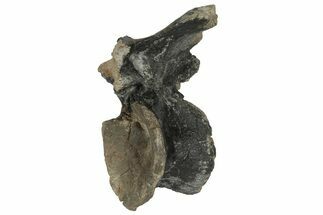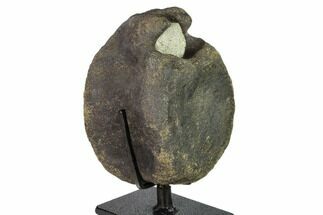This Specimen has been sold.
10.4" Triceratops Dorsal Vertebra on Metal Stand - Wyoming
This is a partial dorsal vertebra of Triceratops horridus, collected from our partner's lease on the Lance (Creek) Formation of Weston County, Wyoming. The preservation of the centrum is beautiful with minimal repair or restoration. The rock has been removed from the neural canal, exposing the cavity that would have contained the spinal cord.
This vertebra measures 10.4" tall by 4.9" wide, with a 3.5" thick centrum. On the custom metal display stand, the entire specimen stands 11.3" tall.
There are repaired cracks at the base of each pedicle, each of which required some gap fill restoration to attach back to the centrum. Some additional repair can be found superior to the neural canal. The processes were lost over the years, likely as a result of weathering away within the ground.
This vertebra measures 10.4" tall by 4.9" wide, with a 3.5" thick centrum. On the custom metal display stand, the entire specimen stands 11.3" tall.
There are repaired cracks at the base of each pedicle, each of which required some gap fill restoration to attach back to the centrum. Some additional repair can be found superior to the neural canal. The processes were lost over the years, likely as a result of weathering away within the ground.
About Triceratops
Triceratops is one of the most recognized and intriguing of the North American ceratopsid dinosaurs. They stomped around the Late Cretaceous (around 68-66 mya), brandishing their three-pronged and bony frilled skulls, chewing on fibrous plants. They struggled against large predators, stood their ground, and tried not to be devoured by the ferocious Tyrannosaurus rex.
The head on a Triceratops may have been an intimidating show rather than a stabbing, defensive trident and imposing shield for inter-species jousting. Researchers have given close scrutiny to the holes, or fenestrae, of other ceratopsid crests. In the past, the holes within the shield were used to confirm separate species.
Individual Triceratops are estimated to have reached up to 9 meters (29.5 feet) in length, 3 meters (9.8 feet) in height, and weighed up to 26,000 pounds. The largest known skull is estimated to have been 2.5 meters (8.2 feet) long and would have extended almost a third of the length of the mature individual. The pointed horns were approximately 1 meter (3 feet) long. With its sturdy build and powerful legs, Triceratops could have ripped open the predator that wanted this herbivore for dinner.
One of the most abundant of the large Cretaceous fauna, Triceratops plucked low growth with its beak-tipped jaws. Triceratops teeth were arranged in groups, called batteries, of 36 to 40 tooth columns, in each side of each jaw. Each column contained about 3 to 5 stacked teeth, depending on the individual’s size. This produced a range of 432 to 800 teeth, of which only a fraction were in use at any given time (due to tooth replacement). The great size and quantity of teeth suggests that they ate large volumes of fibrous plants. These were possibly palms, cycads, and ferns.
Triceratops was designated as the state fossil of South Dakota in 1988.
Triceratops is one of the most recognized and intriguing of the North American ceratopsid dinosaurs. They stomped around the Late Cretaceous (around 68-66 mya), brandishing their three-pronged and bony frilled skulls, chewing on fibrous plants. They struggled against large predators, stood their ground, and tried not to be devoured by the ferocious Tyrannosaurus rex.
The head on a Triceratops may have been an intimidating show rather than a stabbing, defensive trident and imposing shield for inter-species jousting. Researchers have given close scrutiny to the holes, or fenestrae, of other ceratopsid crests. In the past, the holes within the shield were used to confirm separate species.
Individual Triceratops are estimated to have reached up to 9 meters (29.5 feet) in length, 3 meters (9.8 feet) in height, and weighed up to 26,000 pounds. The largest known skull is estimated to have been 2.5 meters (8.2 feet) long and would have extended almost a third of the length of the mature individual. The pointed horns were approximately 1 meter (3 feet) long. With its sturdy build and powerful legs, Triceratops could have ripped open the predator that wanted this herbivore for dinner.
One of the most abundant of the large Cretaceous fauna, Triceratops plucked low growth with its beak-tipped jaws. Triceratops teeth were arranged in groups, called batteries, of 36 to 40 tooth columns, in each side of each jaw. Each column contained about 3 to 5 stacked teeth, depending on the individual’s size. This produced a range of 432 to 800 teeth, of which only a fraction were in use at any given time (due to tooth replacement). The great size and quantity of teeth suggests that they ate large volumes of fibrous plants. These were possibly palms, cycads, and ferns.
Triceratops was designated as the state fossil of South Dakota in 1988.
SPECIES
Triceratops horridus
LOCATION
Weston County, Wyoming
FORMATION
Lance (Creek) Formation
SIZE
10.4 x 4.9", 11.3" tall on stand
CATEGORY
SUB CATEGORY
ITEM
#211082
We guarantee the authenticity of all of our specimens.
 Reviews
Reviews















